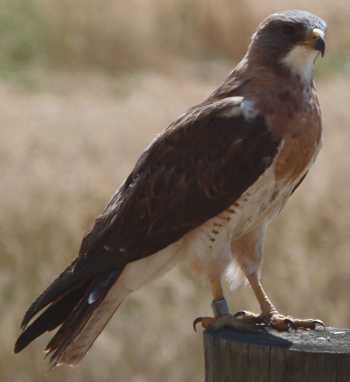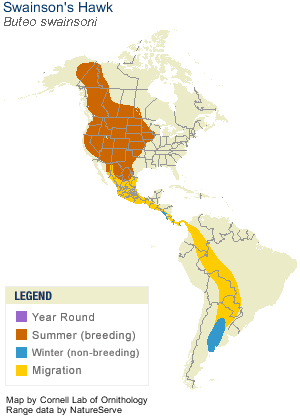 Swainson's
Hawk Swainson's
HawkButeo swainsoni
This species was named after William Swainson, a
British naturalist.
Description
This is one of the most
colorful members of the hawk family. The head,
eyes and underparts are dark brown. A wide
chestnut-colored band across the chest contrasts
with a white throat and pale belly. The light
undersides of the wings contrast with the dark
rear half of the flight feathers. A dark morph
variety is dark brown except for a light patch
under the tail, and a rufous variant is lighter
on the underparts with reddish bars. Young of all
three varieties are similar to adults but with
pale mottling on dark areas and dark mottling on
light areas.
An adult Swainson's hawk stands
about 18 inches high, has a wingspan of up to 48
inches, and weighs about 3 pounds.
 Distribution and Habitat Distribution and Habitat
Swainson's hawks prefer open
prairies and dry grasslands. They breed
throughout much of western North America, and
winter in Argentina.
This species has the longest
migration of any North American hawk, with flocks
from the northern reaches of the breeding range
traveling about 14,000 miles one-way to their
wintering grounds. Large flocks begin moving
south in August, and begin their return flights
in late February.
Diet
Unlike most other birds of
prey, Swainson's hawks feed primarily on insects,
with crickets and grasshoppers being the
preferred food. Insects are caught both in flight
and on the ground, and the Swainson's hawk is
always ready to take advantage of feeding
opportunities brought about by farming operations
and fire. During the breeding season the diet is
supplemented with mice and other small mammals,
as well as birds and reptiles.
Reproduction
Most breeding takes place in
March and April. Breeding pairs appear to be
monogamous for at least one season, with at least
some staying together through multiple seasons.
Nest building is typically done
by the male. The nest itself is a large mass of
twigs and grasses constructed in a tree or on a
ledge, sometimes on the ground. It is not
uncommon for a breeding pair to return to a nest
used in a previous season, with necessary repairs
being done by the male. Two to four white eggs,
each about 2.25 inches long and 1.8 inches wide
and sometimes marked with brown, are laid per
clutch. They are incubated solely by the female
for 28 to 36 days, with the male bringing food to
the female.
Chicks are nearly helpless at
hatching. They are fed small, young mammals while
growing, and can fly on their own in about four
weeks.
Conservation Status
Swainson's hawks are not
considered a threatened species, except in a few
parts of its traditional range where habitat loss
and pesticide use have taken their toll.
Scientific
Classification
Phylum Chordata
Subphylum Vertebrata
Class
Aves
Order
Falconiformes
Family Accipitridae
Genus & Species Buteo swainsoni

All About Birds
www.allaboutbirds.org/guide/Swainsons_Hawk/id
Questions or comments about
this page?
|



